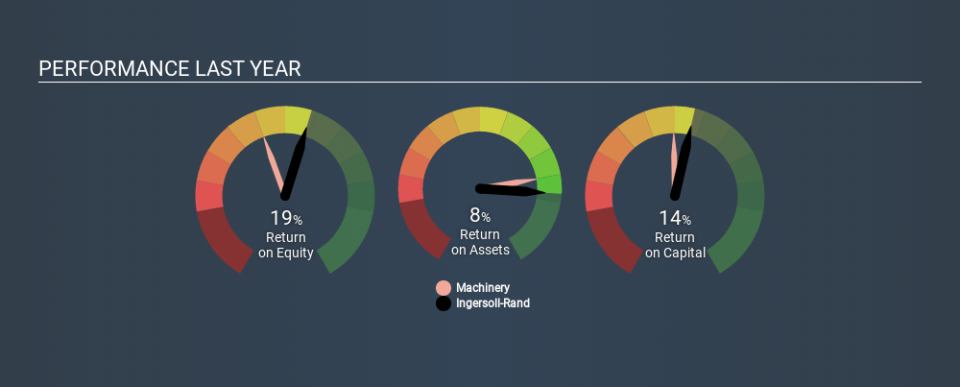Is Ingersoll-Rand Plc's (NYSE:IR) Capital Allocation Ability Worth Your Time?

Today we are going to look at Ingersoll-Rand Plc (NYSE:IR) to see whether it might be an attractive investment prospect. Specifically, we'll consider its Return On Capital Employed (ROCE), since that will give us an insight into how efficiently the business can generate profits from the capital it requires.
Firstly, we'll go over how we calculate ROCE. Next, we'll compare it to others in its industry. And finally, we'll look at how its current liabilities are impacting its ROCE.
Understanding Return On Capital Employed (ROCE)
ROCE measures the 'return' (pre-tax profit) a company generates from capital employed in its business. Generally speaking a higher ROCE is better. Ultimately, it is a useful but imperfect metric. Author Edwin Whiting says to be careful when comparing the ROCE of different businesses, since 'No two businesses are exactly alike.
So, How Do We Calculate ROCE?
The formula for calculating the return on capital employed is:
Return on Capital Employed = Earnings Before Interest and Tax (EBIT) ÷ (Total Assets - Current Liabilities)
Or for Ingersoll-Rand:
0.14 = US$2.1b ÷ (US$20b - US$4.8b) (Based on the trailing twelve months to September 2019.)
Therefore, Ingersoll-Rand has an ROCE of 14%.
Check out our latest analysis for Ingersoll-Rand
Does Ingersoll-Rand Have A Good ROCE?
ROCE is commonly used for comparing the performance of similar businesses. Using our data, Ingersoll-Rand's ROCE appears to be around the 11% average of the Machinery industry. Separate from Ingersoll-Rand's performance relative to its industry, its ROCE in absolute terms looks satisfactory, and it may be worth researching in more depth.
The image below shows how Ingersoll-Rand's ROCE compares to its industry, and you can click it to see more detail on its past growth.
When considering ROCE, bear in mind that it reflects the past and does not necessarily predict the future. Companies in cyclical industries can be difficult to understand using ROCE, as returns typically look high during boom times, and low during busts. This is because ROCE only looks at one year, instead of considering returns across a whole cycle. What happens in the future is pretty important for investors, so we have prepared a free report on analyst forecasts for Ingersoll-Rand.
What Are Current Liabilities, And How Do They Affect Ingersoll-Rand's ROCE?
Liabilities, such as supplier bills and bank overdrafts, are referred to as current liabilities if they need to be paid within 12 months. The ROCE equation subtracts current liabilities from capital employed, so a company with a lot of current liabilities appears to have less capital employed, and a higher ROCE than otherwise. To check the impact of this, we calculate if a company has high current liabilities relative to its total assets.
Ingersoll-Rand has total liabilities of US$4.8b and total assets of US$20b. Therefore its current liabilities are equivalent to approximately 24% of its total assets. Current liabilities are minimal, limiting the impact on ROCE.
Our Take On Ingersoll-Rand's ROCE
This is good to see, and with a sound ROCE, Ingersoll-Rand could be worth a closer look. Ingersoll-Rand shapes up well under this analysis, but it is far from the only business delivering excellent numbers . You might also want to check this free collection of companies delivering excellent earnings growth.
If you like to buy stocks alongside management, then you might just love this free list of companies. (Hint: insiders have been buying them).
If you spot an error that warrants correction, please contact the editor at editorial-team@simplywallst.com. This article by Simply Wall St is general in nature. It does not constitute a recommendation to buy or sell any stock, and does not take account of your objectives, or your financial situation. Simply Wall St has no position in the stocks mentioned.
We aim to bring you long-term focused research analysis driven by fundamental data. Note that our analysis may not factor in the latest price-sensitive company announcements or qualitative material. Thank you for reading.

